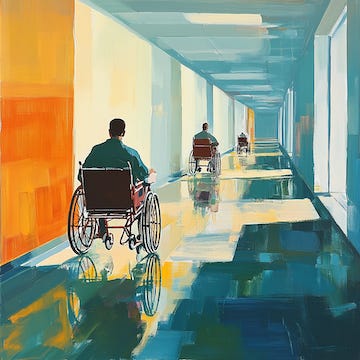The Pain Was Awful
I would have gone to the ER, if I thought there was anything they could do.

Part 2 in a 4-Part Series
Part 2 of my pain journey starts at the Mayo Hospital. And no, this is not a hospital trying to prove the merits of a specific condiment as the preference. (I used to wonder about that.)
Like all well-established buildings with weird names, Mayo is named after the person who founded and funded the start of the building and the entire medical existence of the Mayo Clinic that is so well known today.
Going to the Mayo Clinic is like taking your diamonds in for deep cleaning. They leave no stone unturned.
Testing… 1… 2… 3… Testing… 1… 2… 3…
They do every test and have you consult with every expert. Even if you’ve had a specific test before, they want to re-do it using their lab techs, their equipment and their doctors to interpret the results. I was going to be cared for and handled like expensive jewelry.
I flew in on a Sunday night and stayed over a week until the following Tuesday.
Mayo always has a dystopian feel to me, as I flashed back to a previous trip there in 2017. There is, of course, a lab where all Mayo patients are sent for bloodwork. After the lab techs draw out the blood samples, the techs wrap the patient’s elbow with a colored bandage to prevent post-prick bleeding.
We would be out to eat dinner in one of the restaurants near the main Mayo Campus and would see everyone walking around with the color du jour wrapped around their elbow from their earlier lab visits. It almost felt like walking zombies. Almost.
Mayo ran me through every test under the sun.
Nothing showed up as far as a tumor or the big thing to point to, as in ah, this is it.
One of the MRIs did show some partially torn muscles, which ended up not meaning much, but it felt good that one of the tests registered something vs being a total waste. I know that sounds kooky. That’s how my crazy mind works.
While it’s nice to get that comfort level that nothing really bad is wrong, it also feels awkward trying to explain how bad the pain can be or how difficult it is to live life when my “problem” is not easily definable, like something you can point to and say “see, this is why I’m having such an issue.” Are you sure those tests don’t point to anything more serious?
I also recalled how walkable the Mayo Campus is. And for every sidewalk, there is an indoor passageway connecting all the medical buildings. That passageway extends to some of the nearby hotels and restaurants, creating that dystopian village with the colored bandages.
This visit, however, I was unable to do any of the walking as the pain was awful. Each day, I took the shuttle from my hotel to the very efficiently run dropoff area at the central Mayo check-in building.
Wheelchair? No, thank you.
It took me a couple days to realize that they offer a free wheelchair service around the campus. Even though I was traveling alone this time, their service offered a free valet to push the wheelchair wherever I was going. I would not, however, need a wheelchair. I’m fine. It took me another day or two to concede to requesting a wheelchair. The pain was awful.
Mayo is a very efficiently run operation, making the productivity nut in me drool, and very curious how they pull it off. The wheelchair valets coordinate with the central dropoff area when wheelchairs are needed for incoming patients and the valets ask if you’re meeting up with a shuttle to ensure it won’t leave without you.
Me riding in a wheelchair, however, was a very disheartening feeling. Had it really come to this? 57 years old and being pushed around in a wheelchair because walking is too much for me. It made me feel very sad. I don’t typically go to a place where I feel sorry for myself because of this awful pain issue, but this did it.

The Mayo Solution
Mayo’s recommended treatment plan was a multi-pronged approach. There was not one distinct issue, there were many. So the solution was the same. Mayo also follows the philosophy that they help to solve the mystery, but they prescribe the solution. They expect you to find your care team at home locally. This was easier said than done.
Pelvic Floor Physical Therapy
They recommended physical therapy (PT). I had a physical therapist, but she wasn’t able to solve this. We had already been there. I realized I needed to find the right PT, properly skilled in nerve issues in addition to being an expert at pelvic floor PT.
Mayo provided a website where I could search local PTs and understand their certifications and credentials to make an educated and informed choice for a pelvic floor PT.
In all my 7 previous years of off-and-on pelvic floor PT, I had 2 PTs that had the caliber needed to treat my issues up to that point: one of them apparently did not treat nerve pain and the other was no longer geographically desirable. (However, if I did not have success soon, I may be willing to drive the 1 hour each way, at least 1x a week, to get the level of care needed. This would become a more significant challenge when my medical leave of absence ended and I had to go back to work.)

I hit the jackpot! I found a PT less than 10 minutes from my house. Her credentials are very similar to the 1-hour-away PT and I was able to get in right away.
Medication
Mayo’s recommendation was a medication change, as the nerve-related one I’d been taking was not resolving the pain. There was a complexity in that the current med I was taking also treats another invisible illness I have, restless leg syndrome (RLS). The new med would also mean making tweaks in my RLS medication protocol. On top of the original appointment schedule, I was sent to see a neurologist at Mayo as well for their recommendation on the RLS med changes.
Recall/refresher from part 1: I want to avoid getting into the details of which medications and what dosages I’ve tried, as this is not about that. It’s really about how I am my own best advocate to get the answers and treatment I need.
At the time of this writing, I’ve been on the new med for about 3 months. We’ve continued to increase the dosage approximately monthly to try to get to the optimal level.
Other Treatments
I recognize that my specific type of pain (pelvic floor) can be more uncomfortable to read about than if it was back pain, for example. I get it. I pick and choose when to say those extra words to describe my pain when talking to people. And cheers to you if I you’re still reading even though it made you a little (or a lot) uncomfortable.
In that vein, I’m not going to go into specific detail on a couple of other treatment solutions Mayo gave me. It’s not for the casual reader.
If you suffer from pelvic floor pain and would like more detail on these treatments, feel free to message me privately by replying to the email that sent you this article or comment below where I can privately message you.
What I will say is that it took 4 attempts with 4 different brands with one of their recommendations and 2 intensity-level attempts with another to get to a treatment that feels like it is going down the right path.
“Your pain is real. It’s very real, however…”
Find out when and why I heard this phrase multiple times by tuning into the last piece of the Mayo Solution in next week’s article, part 3 of this series.
To receive part 3 of this series and other future newsletters directly in your inbox, be sure to sign up for a free subscription now. Or upgrade to paid for more reader benefits.



